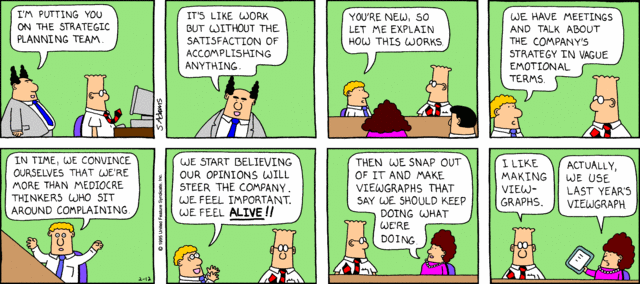What's Missing in Strategic Planning ~ Pt 1
We tackle 20 year problems with five year plans staffed by two year personnel funded by one year appropriations. Harlan Cleveland
Here's some direct quotes I've heard in the past nine months from executives and organizational leaders (not necessarily the same thing).
"We had a strategic plan in 2004 and it's sat on the shelf ever since."
"I saw it once, but it's 60 pages long and who's got time
with all of the daily work we have to accomplish."
"We spend a week working on it every year,
then change the dates on last year's plan."
 |
| Copyright Scott Adams: www.dilbert.com |
Across the country I have seen a startling move to strategic planning efforts where the entire process consists of several emails and phone calls, followed by a one day group facilitated discussion. At the end of the day, there's a plan achieved by consensus and everyone goes back to work. I particularly like Brian Robertson's work in Agile Project Management and Holocracy which differentiates consensus from consent because he's right on track. Here's my twenty cents on what's missing:
- Strategy: Setting a financial goal is not a strategy. It's a goal. Determining the actual initiatives, tactics and action plans which help us achieve our strategies to reach the goals is imperative and can't be done in a day. We also need to put in place measurements and metrics to check progress, but not at the level that completing reports is so cumbersome we can't do the work that gets us there.
- Stakeholder Engagement: Too often we gather together some of the most brilliant leaders we have in the organization to create plans and then send them out for everyone else to follow. Which is probably why according to William Schieman's research, only 14% of our employees understand the company strategy. Certainly depending on the size of the organization it's not possible to create a strategic planning committee that's so large nothing ever gets accomplished. That doesn't mean we can't include a full range of
 stakeholders: Board, Management, Support Staff, Clients, IT, Finance, etc. If we want those who have to carry out the work to be fully committed, then we need to hear from them before implementation. The fact we often don't is reflected in Gallup's (and others) work showing that nearly 80% are either unengaged (uninterested) in the work we're paid to do or completely disengaged (and detrimental to organizational objectives and productivity).
stakeholders: Board, Management, Support Staff, Clients, IT, Finance, etc. If we want those who have to carry out the work to be fully committed, then we need to hear from them before implementation. The fact we often don't is reflected in Gallup's (and others) work showing that nearly 80% are either unengaged (uninterested) in the work we're paid to do or completely disengaged (and detrimental to organizational objectives and productivity). - Boiler Plate Plans: I see this far too often where those facilitating pull out the same data, process and solutions they've presented to any number of other organizations, change the logos and off we go into the documents and plans that get shelved and don't produce intended results because they weren't personal to our organization. That doesn't mean we don't look at best practices and consider multiple scenarios. But to be truly effective across organizational hierarchies and believed by followers so they'll enact the strategies, we have to consider the intricacies of our team, their competencies and the resources available.
- Mission, Vision & Values: It's not that these don't exist but far too often they are platitudes created in a bubble and placed on the walls, but not practiced. As with the lack of understanding company strategy, we regularly find that these statements mean completely different things to leadership, followers and clients. When we align mission, vision and values among the various stakeholder groups, adaptability, sustainability and profitability dramatically increase.
- Consistent Communication Reinforced: Just as we individually have different learning styles for how we acquire new competencies, our teams absorb data and concepts through multiple mediums.
A lengthy single spaced plan with heavy details will put most folks to sleep. It still needs to be created, but there must be consistent communication throughout the organization in multiple forms: charts, graphs, posters, video, social media, etc. The graduate students who just finished our strategic planning class did phenomenal research for two different non-profits in the region resulting in 40 pages of data and recommendations. The PowerPoints they created to go back to organizational leadership were 12 slides each. Clear, concise and graphically powerful.

It's a good thing I don't have an opinion on the matter though. Imagine how long this would have been if I did. Part two will come in July.




Comments
Post a Comment
Thank you for sharing your worldview.